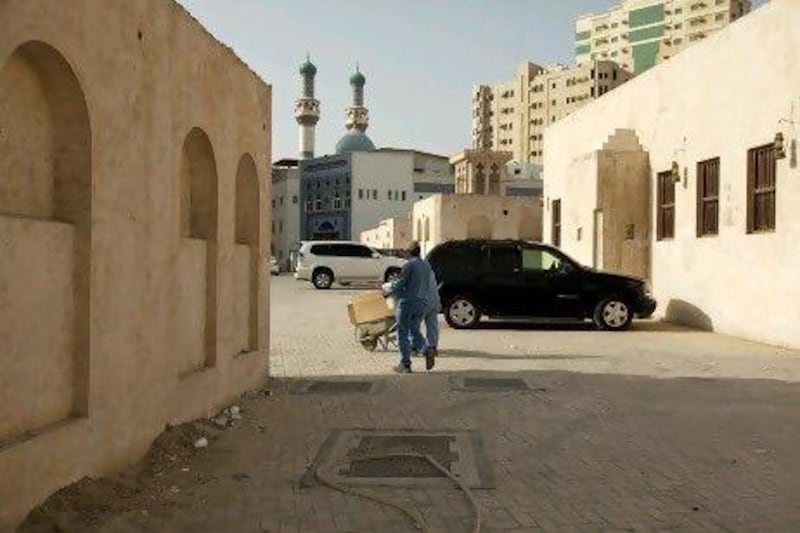SHARJAH // Mohammed Abdul Rahman Al Zarooni set up shop at Souq Saqr more than 50 years ago, yet in the grand scheme of Sharjah's oldest neighbourhood he is a recent arrival.
The changes he has seen are epitomised by the doors of the shops around him. "Before they were big heavy wooden doors," he says, "now we have glass fittings in the front."
Merchants dealing in clothes, food and gold first moved in to Al Shuwaiheen at the end of the 18th century, when women would sit on the top floors of Barjeel houses made of limestone and rock from Abu Musa, producing buttons for sale.
Today, sitting outside his textiles shop in the Arts Area, Mr Al Zarooni waits for the influx of customers he and other shop owners have come to expect following Maghrib prayers. From this vantage point he has witnessed the souq's transformation along the years, and often stops to discuss the changes with his fellow merchants, tailors and oud sellers.
Mr Al Zarooni, 72, puffs on a cigarette as he strains to remember his early days at the souq - which he refers to as Souq Al Qadeem. Two of his seven sons were born in the nearby Bait Al Serkal building, a 150-year-old, three-storey structure converted into the Sarah Hosman Hospital in the 1960s.
However, he cannot remember which of his sons were born there, nor the specific date - "I think it was 40 years back," he says.
The building's days as a hospital have long ceased - today it houses the Sharjah Art Institute.
But other memories for Mr Al Zarooni are more clear.
"The Ruler lived right behind the souq where the Al Hisn Fort is and we had officials coming here all the time. I would see them through my shop window," he says.
The leaky areesh, or date palm fronds, that once made up his roof have been replaced as part of the 15-year Heart of Sharjah project, which aims to recapture the old footprint of the town. The new roof is made of fresh fronds and metal, and paving has been introduced between its shops. Fans have been introduced in its marketplace.
"Here it was all sand and mud before and the road was very small," Mr Al Zarooni recalls. "Now it is a masboot [strong] road and there are more shops."
Al Shuwaiheen's markets and museums attract a mix of art lovers, history seekers and bargain hunters.
Hamda Homud, a 20-year-old Emirati student from Al Ain, often heads to the market with her family. She is fond of the knick-knacks, hairpins and bags which she says she can find nowhere else. "Here the shops are 50 per cent cheaper than those in Al Ain," she says.
"We can haggle here and we trust the tailors. It is far but it becomes an outing on the weekends."
Badshah Khiyal Badshah, a 56-year-old from Pakistan, has been working for Mr Al Zarooni for 30 years. He pulls out red and yellow embroidered cloth from among the colourful rolls of fabric. "It's not the same anymore," he says.
"We used to get 50 to 60 customers. We still get customers from Oman, Saudi and Dubai, but fewer."
"People were simple then. They wanted things we sold."
Peter Jackson, the architectural adviser in the Ruler's office overseeing the project, has been visiting Al Suwaiheen since the 1970s."This was a bustling souq, very different from the main souq in Deira," he says. "It felt like a real place and still feels like one. One thing I would never get over back then was the various smells of spices."
It's partly this assault on the senses that keeps him coming back.
"I like the sheer variety and visual chaos to this area," he continues. "But there is order in this chaos. It is completely different from a shopping mall."
[ aahmed@thenational.ae ]
@ For more stories in this series, click here.






